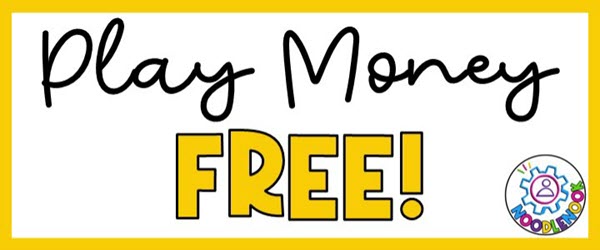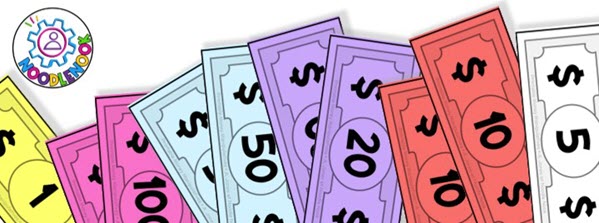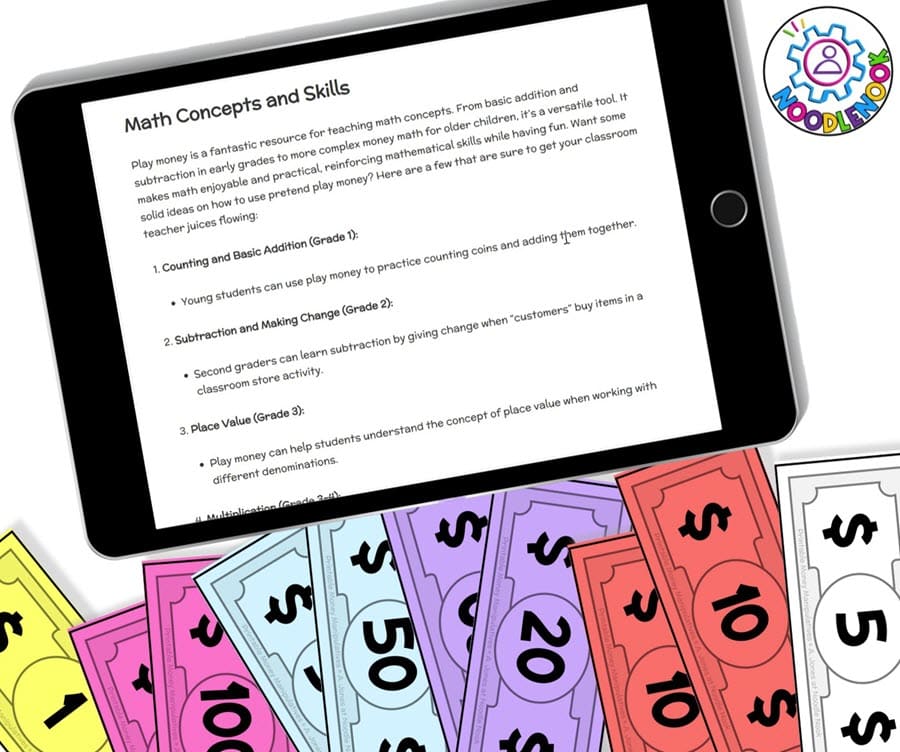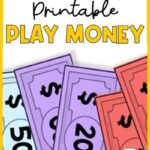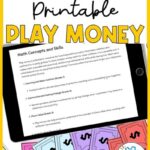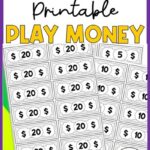Let’s start by addressing the importance of play money in educational settings. Play money serves as an excellent tool to teach young learners the value of money without using real currency. It’s a great way to introduce the concept of money and its real-world applications to students of all ages. I love having free printable play money for math in the classroom to practice tons of skills (without actually having to keep tabs on the real thing). In this blog post, I will hook you up with some great fake money printables as well as provide you with ideas on a fun way to incorporate them into the classroom.
The Value of Money
Of course, we all know that money has value. Using pretend money in different ways with students starting at an early age is extremely valuable. When you start using free printable play money in the classroom, you start building crucial financial literacy skills. Kids can grasp the concept of money, its various denominations, and how it works in the real world. This is a fundamental skill that sets the foundation for their financial future.
Different Denominations and Currencies
I can remember way back in the good old days when I was teaching 1st grade standing over our campus copying machine running duplicates of the bank notes from my purse. Don’t tell the feds… It was my own bootleg way to make play paper money that looked realistic. I needed printable dollar bills and coins in different denominations, mimicking real money. But here is the problem… copying money on the copier in its actual size is highly illegal! If you want to read more about that, check out this post.
It could make for a great conversation with older kids on why we use fake cash in class. As you look for your money manipulatives, get a variety of bills. This diversity allows you to create various classroom activities, from math lessons to classroom stores. Teachers can even introduce different currencies from other countries to broaden students’ horizons. Another great conversation may be why most countries use the same denominations and if there is a thousand-dollar bill!
How to Use Money in the Classroom
There are so many educational uses for principal fake money during classroom activities. The best part is that these money manipulatives are perfect in special education as the best way to make learning hands-on.
Math Concepts and Skills
Play money is a fantastic resource for teaching math concepts. From basic addition and subtraction in early grades to more complex money math for older children, it’s a versatile tool. It makes math enjoyable and practical, reinforcing mathematical skills while having fun. Want some solid ideas on how to use pretend play money? Here are a few that are sure to get your classroom teacher juices flowing:
- Counting and Basic Addition (Grade 1):
- Young students can use play money to practice counting coins and adding them together.
- Subtraction and Making Change (Grade 2):
- Second graders can learn subtraction by giving change when “customers” buy items in a classroom store activity.
- Place Value (Grade 3):
- Play money can help students understand the concept of place value when working with different denominations.
- Multiplication (Grade 3-4):
- Students can use play money to learn multiplication by counting groups of bills or coins.
- Division (Grade 4):
- Division can be taught using play money when dividing a sum of money among a group of people or “investors.”
- Money Word Problems (Grade 3-5):
- Money-themed word problems can be created to enhance problem-solving skills in these grade levels.
- Decimals (Grade 4-5):
- Students can explore decimals by working with play money values less than a dollar, such as cents.
- Percentages (Grade 5):
- Play money can be used to teach percentages when calculating discounts or sales tax.
- Budgeting and Financial Literacy (Grade 6 and up):
- Older students can learn budgeting skills by managing their play money for various expenses.
- Real-World Money Scenarios (Middle School and High School):
- Play money can be used to simulate real-world financial scenarios like paying bills, managing a bank account, or investing.
- Probability and Statistics (High School):
- Students can use play money to explore probability and statistics in gambling-related activities.
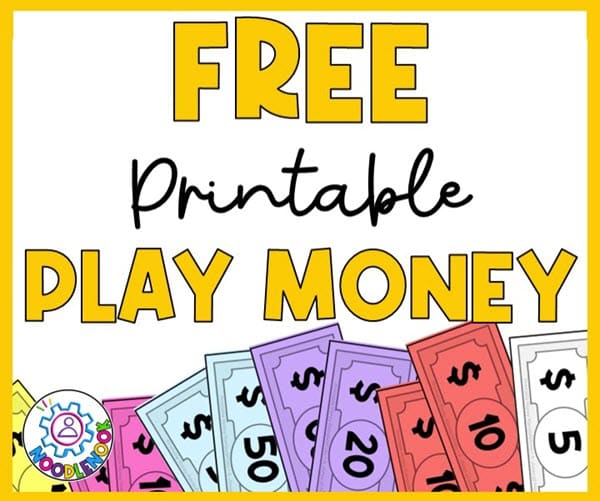
Classroom Activities
On top of addressing math concepts and skills, there are tons of educational activities that are perfect to use with your printable fake money.
One-dollar bills, printable coins, and even printable monopoly money can be used for all kinds of fun activities. Whether it’s setting up a classroom store, playing money bingo, or simulating real-life financial scenarios, play money keeps students engaged. Here are a few ideas to add to your money lesson plans:
- Classroom Store (All Grades):
- Create a classroom store using play money. Assign different values to items such as school supplies, toys, or snacks. Students can “shop” for items and practice addition and subtraction as they make purchases and receive change. I love this one here with fast food! Believe me, your students will be begging you to do math!
- Money Bingo (Grade 1-3):
- Play a game of Money Bingo where students have bingo cards with different coin values, and you call out amounts in play money. This game helps reinforce recognition of coin values and counting skills.
- Budgeting Project (Grade 4 and up):
- Give students a budgeting project where they have to plan a pretend event or vacation using play money. They need to budget for expenses like transportation, accommodation, and activities, helping them understand financial planning. As a real-world activity, try one about going to the grocery store! It’s something everybody does and is highly relatable. This is a great activity that works well with most printable play money templates. Students can shop for favorite food items (like ice cream). You can even have someone pretend to be the cashier and make change or be the pretend bank and cash checks! See, so many options here.
- Math Challenges (Various Grades):
- Create math challenges that involve play money. For example, present scenarios where students have to calculate discounts, calculate tips at a restaurant, or determine the total cost of a shopping trip.
- Financial Literacy Game (Middle School and High School):
- Use financial literacy board games where students navigate through life scenarios, such as paying bills, saving, and investing, using play money. In fact, any activity that helps them learn about real-world financial decisions is great. I love this one where you can do it as a warm-up every day. Over the course of a month, students are faced with a ton of real-life decisions and consequences.
One of the best parts about using play money in the classroom is its real-world application. It prepares students for handling real money in adulthood. They learn how to make change, budget, and make informed financial decisions.
Another Way to Use Money Manipulatives
We are all working to reinforce money skills as much as possible… so why not use it as part of your positive behavior reward systems? Think about it… Play money can be integrated into behavior charts and classroom management. It’s a creative way to promote good behavior and a positive attitude among students.
PLUS, your students are constantly counting and budgeting with their rewards. They can earn pretend cash for their good deeds on their behavior chart. This can help in creating a sense of responsibility. You can also value different behaviors or things at different rates. Maybe a clean workspace is a 5er, but quiet feet in the hallway is just worth a dollar note. There is so much flexibility! It’s also a great way to teach that different behaviors are more or less important than others.
Where to Find the Best Money Manipulatives
There are a lot of different play money design options to consider. If you prefer to save on ink and order with delivery to your doorstep, then check out these three options. P.S. These are affiliate links, and when you use them to order, you support my mission to help teachers find success in the classroom, TIA.
- MOST REAL: Movie Money Props, Real Looking Money for Every Use.
- MOST AFFORDABLE: Play Money for Kids and Toddlers, Bills and Coins.
- MOST TEACHER-Y: Jumbo Magnetic Money for Learning.
Interactive Resources and Digital Classroom
In today’s digital age, you can find free printable play money in PDF format online. This makes it easily accessible for teachers, homeschool moms, and even parents. It’s a valuable resource for both physical and digital classrooms. I love this site for all their digital manipulatives, and they are totally free.
FREE Printable Money Template (PDF File)
Okay, okay… are you ready to get your hands on this free resource? I feel you, free printables are the best #TeacherLife. These do not have back sides, just fronts with denominations that print easily on colored paper to make them green (if you want). In fact, you could print them on a bunch of different color papers to designate them for a specific student or task. You could also do it to help create complete ‘sets’ of play money.
Since this play money is for personal use and educational purposes, it ensures privacy and safety. You can teach the value of money without any concerns about the security of real coins or notes.
RECAP: FREE Printable Play Money for Math in the Classroom
To wrap up, you have plenty of options for free printable play money. On top of that, it’s an invaluable resource for educators and parents alike. It’s a fun and engaging way to teach math skills, financial literacy, and the value of money. With different denominations, currencies, and a plethora of creative activities, it’s a must-have in any educational toolbox. If you have not grabbed your FREE printable classroom money template, click here to get yours now.

